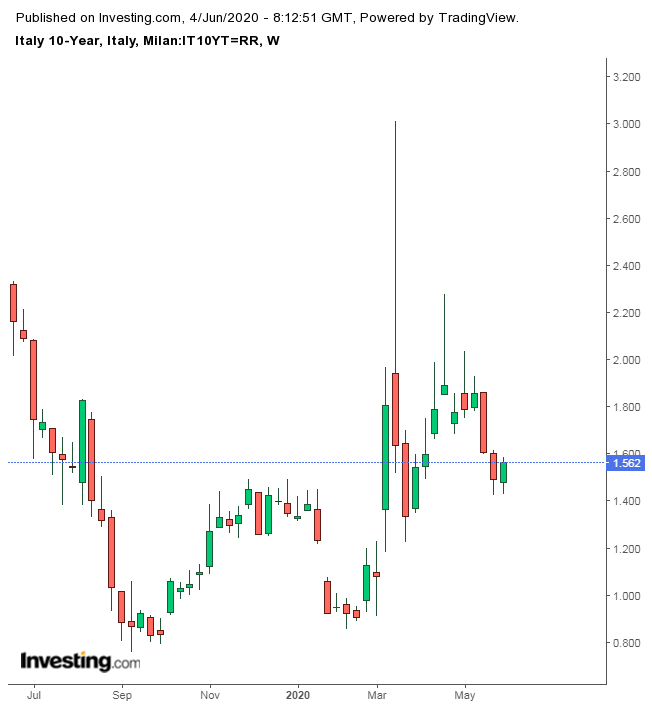Yields on Italian government bonds have had a roller coaster ride over the past few weeks as European Central Bank asset purchases kick in, with the ECB poised to increase its coronavirus stimulus on Thursday by €500 billion to €1.25 trillion.
The European Union, in the meantime, is debating a proposal to borrow €750 billion to fund a recovery facility for grants and loans to the hardest-hit regions and industries.
Italy stands to benefit disproportionately from both measures, as EU authorities scramble to make up for ECB president Christine Lagarde’s gaffe in March that it is not the central bank’s job to narrow the spreads between yields on the sovereign bonds of eurozone members.

Yields on the 10-year Italian bond—already higher from February lows due to the ravages of the pandemic—shot up 180 basis points on her remarks, drawing Rome’s fury at the lapse by the ECB chief. Despite reassurances in the meantime, the bonds have not fully recovered.
Since bond yields move inversely to prices, an increase in yields reflects a decline in prices as investors dumped the Italian bonds.
Equally important, particularly for currency traders keen on gauging the strength of the euro, the spread between the Italian 10-year bond and the German 10-year widened.

It ebbs and flows with the Italian yield as the German bond, the bund, has remained fairly steady with a negative yield of -35 to -40 bp.
That spread still stands at about 190 bp as the yield on Italian bonds has only declined to about 1.57 percent after briefly topping 3 percent intraday in the wake of Lagarde’s remarks, stretching the spread with the bund to 290 bp by the close.
For a nation already under siege as the first European country to bear the brunt of the pandemic, Italians reacted sharply and began to question EU membership when there was so little solidarity. The ECB launched its Pandemic Emergency Purchase Programme with €750 billion in part to soothe Italian authorities, setting aside its normal caps on purchases from each country in the new facility.
Data released on Tuesday showed that the ECB spent €37.4 billion on Italian government bonds in April and May under the emergency program, €8.1 billion more than would be allotted under its capital key, its share in the ECB based on population and GDP. Indeed, the ECB is now doing precisely what Lagarde said was not its responsibility.
In addition, the ECB bought up nearly €14 billion of Italian bonds under its regular Public Sector Purchase Programme in the past two months.
This ECB support allowed Italy to sell a record €22.3 billion in 5-year bonds over four days to May 21 with another successful sale of €2.5 billion on May 29. On Tuesday, the Italian Treasury announced it had mandated a bank consortium to manage syndication of more bonds.
At the same time, some €82 billion of the EU’s proposed recovery fund is earmarked for Italy, with a similar amount for Spain, and less for other countries.
However, that facility faces opposition from several EU members as well as members of Germany’s coalition government. As such, it could take weeks of haggling to get the program approved and it may be modified (that is, decreased) along the way.
In the meantime, the bumpy ride for Italian bond yields and spreads will continue. Since Italy no longer has its own currency, it cannot alleviate the stress with a devaluation as it has in the past.
The outsized spreads between government bond yields were one of the major strains in the EU’s sovereign debt crisis, which peaked between 2010 and 2012, leading to traumatic bailouts of Greece, Ireland, Portugal, Spain, and Cyprus under management of the troika of the European Commission, ECB, and International Monetary Fund.
EU officials, and even German leaders, seem to have learned a lesson from that crisis. Still, it remains to be seen whether the planned EU aid will come with strings attached, even if it is less onerous than those earlier bailouts.
